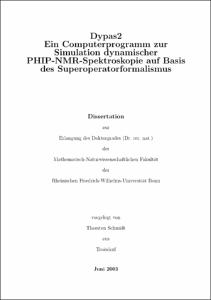Dypas2Ein Computerprogramm zur Simulation dynamischer PHIP-NMR-Spektroskopie auf Basis des Superoperatorformalismus

Dypas2
Ein Computerprogramm zur Simulation dynamischer PHIP-NMR-Spektroskopie auf Basis des Superoperatorformalismus

| dc.contributor.advisor | Bargon, Joachim | |
| dc.contributor.author | Schmidt, Thorsten | |
| dc.date.accessioned | 2020-04-06T10:31:42Z | |
| dc.date.available | 2020-04-06T10:31:42Z | |
| dc.date.issued | 2003 | |
| dc.identifier.uri | https://hdl.handle.net/20.500.11811/1917 | |
| dc.description.abstract | For in situ studies of reaction mechanisms using parahydrogen it is desirable to compare experimentally recorded NMR spectra with those theoretically expected. Likewise it is advantageous to know, how the individual intensities of the intermediates and reaction products depend on time. For this purpose we have developed a computer simulation program DYPAS2 which is based on the density matrix formalism using superoperators, implemented under the C++ class library GAMMA. DYPAS2 offers a large variety of simulation modes and allows to calculate the polarization patterns of the expected NMR spectra derived either from parahydrogen or orthodeuterium. Furthermore, the individual boundary conditions can be taken into account, under which the hydrogenations take place. Accordingly, the magnetic field dependence of the resulting polarization patterns can be predicted, for example in spectra based on the PASADENA or ALTADENA effect, respectively. The kinetics of the hydrogenation transfer is covered by the use of an exchange superoperator assuming a pseudo first order reaction. Thereby competing hydrogenations of the substrate to more than one product can also be accommodated. In addition, the consequences of relaxation effects or NOE's can be included into the simulations if desired. Furthermore, it is possible to simulate the consequences of different types of pulse sequences, such as PH-INEPT or INEPT+, which have previously been developed for the transfer of polarization from the parahydrogen-derived protons to hetero nuclei like 13C or 15N. The individual delays required in these pulse sequences are critical parameters for the associated magnitude of the transferred polarization, but it is not trivial to estimate their optimal values. Therefore, - and in particular for large spin systems, - it is desirable to obtain access to intensity plots, which display the calculated intensities of the polarization-enhanced NMR spectra of the hetero nuclei as a function of the individual delay times. DYPAS2 contains this option and provides an even greater variety of other possibilities. | en |
| dc.language.iso | deu | |
| dc.rights | In Copyright | |
| dc.rights.uri | http://rightsstatements.org/vocab/InC/1.0/ | |
| dc.subject | NMR | |
| dc.subject | PHIP | |
| dc.subject | Spektroskopie | |
| dc.subject | Simulation | |
| dc.subject.ddc | 540 Chemie | |
| dc.title | Dypas2 | |
| dc.title.alternative | Ein Computerprogramm zur Simulation dynamischer PHIP-NMR-Spektroskopie auf Basis des Superoperatorformalismus | |
| dc.type | Dissertation oder Habilitation | |
| dc.publisher.name | Universitäts- und Landesbibliothek Bonn | |
| dc.publisher.location | Bonn | |
| dc.rights.accessRights | openAccess | |
| dc.identifier.urn | https://nbn-resolving.org/urn:nbn:de:hbz:5n-02293 | |
| ulbbn.pubtype | Erstveröffentlichung | |
| ulbbnediss.affiliation.name | Rheinische Friedrich-Wilhelms-Universität Bonn | |
| ulbbnediss.affiliation.location | Bonn | |
| ulbbnediss.thesis.level | Dissertation | |
| ulbbnediss.dissID | 229 | |
| ulbbnediss.date.accepted | 24.06.2003 | |
| ulbbnediss.fakultaet | Mathematisch-Naturwissenschaftliche Fakultät | |
| dc.contributor.coReferee | Woelk, Klaus |
Files in this item
This item appears in the following Collection(s)
-
E-Dissertationen (4413)




